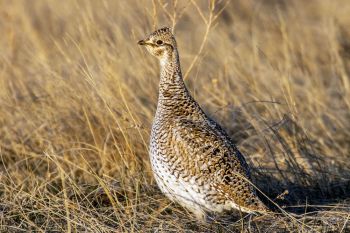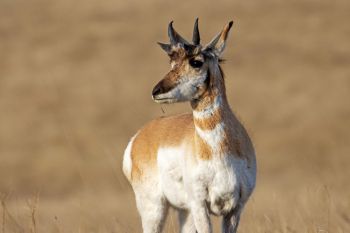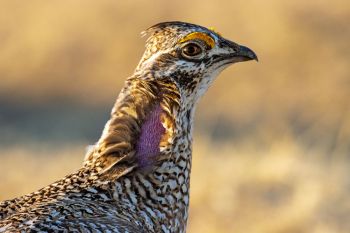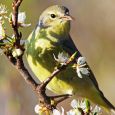The Gift of South Dakota
Subscriptions to South Dakota Magazine make great gifts!
Subscribe today — 1 year (6 issues) is just $29!
High Plains Heaven
Apr 15, 2021
Every April, the Fort Pierre National Grasslands staff set up three blinds in the prairie hills southwest of the capital city. The reason? To provide the public an opportunity to watch something quite special in the early-morning hours. Greater Prairie-Chickens and Sharp-tailed Grouse gather at their respective leks and begin to dance. Rain or shine, cold or warm, snow or sun, the males arrive in their respective areas about an hour before sunrise and start to coo, cackle, woo and whir, all with a singular goal: impress the ladies. In my years of watching, I’ve never seen hens actually respond receptively as they make their shy and diminutive way through the leks. But they do watch the dancers quite closely, often right up until the closest male gets a little too close for comfort and then the hen moves quickly on. Who knows? Maybe playing hard to get is all part of the process.
I’m not a scientist, but I love our wild grasslands and the hidden treasures they sustain. I grew up in Sharp-tailed Grouse country, but I never saw their spring dance before sitting in a blind at the Fort Pierre National Grasslands. As a photographer, the colorful and quick displays are challenging to capture. The Greater Prairie-Chicken’s style is a little different in that they aren’t quite as fast on their feet but employ a bit more color and sound into their routine by filling bright orange neck sacs with air. The “wooing” sound that comes next is referred to as “booming” and can be heard from miles away on a clear and calm morning.
Unfortunately, the two mornings I spent in the blinds this spring were not very calm. The wind has been extra active this time around the sun; the first morning it was gusting above 20 mph well before dawn. The temperature dropped below 20 degrees, and although the blind cut down the wind’s bite it was bone chilling, and I was happy for extra blankets and long johns. Still, the prairie chickens danced and boomed. When the sun finally climbed above the horizon, the warm light revealed around 18 males spread out on the hilltop along a two-track prairie trail. Some were fighting, some were squawking, and I even saw a few hens stroll through. To be smack dab in the middle of this ancient dance on the prairie made suffering through the cold worth it.
A couple days later, I was in another blind a little farther south. Here, sharpies danced all around the blind. They clicked and clucked and stamped their feet so rapidly that even my fast shutter speed couldn’t capture the action without a blur. More hens arrived and all the fellas picked up their pace. A couple meadowlarks joined in with their signature song and I was in high plains heaven.
A heartfelt thanks to the grasslands staff for providing this opportunity at no cost every year. They say that birders and enthusiasts come from all over the world to watch our prairie dancers. You can too through the rest of April. Simply contact the office to reserve a blind, get up well before the sun, settle into your blind and prepare for show like no other.
Christian Begeman grew up in Isabel and now lives in Sioux Falls. When he's not working at Midco he is often on the road photographing South Dakota’s prettiest spots. Follow Begeman on his blog.




























Comments